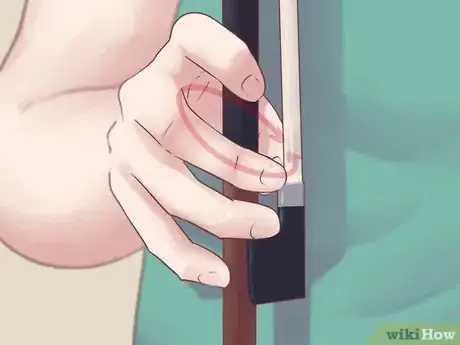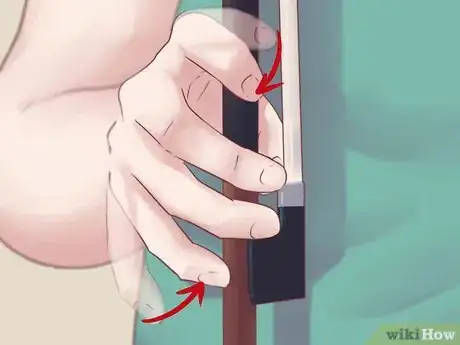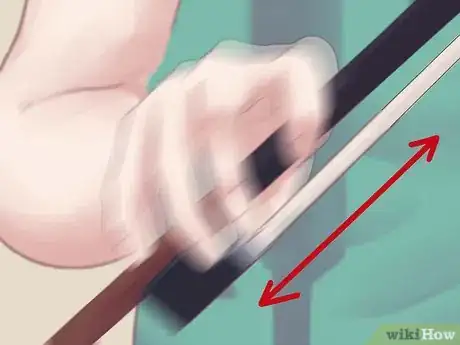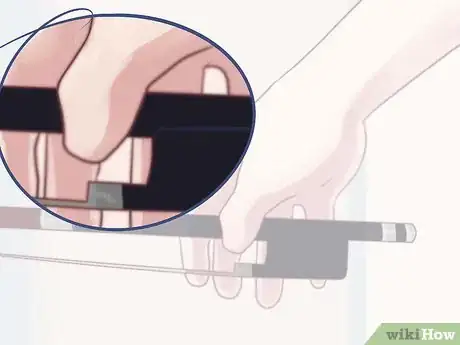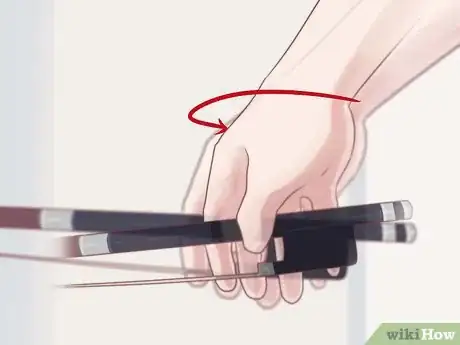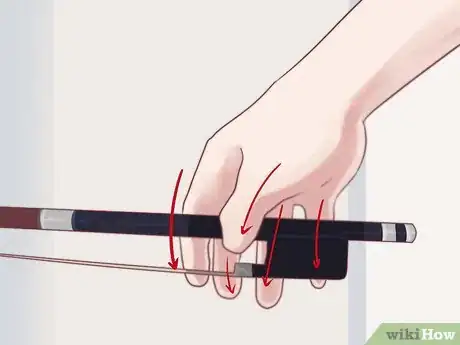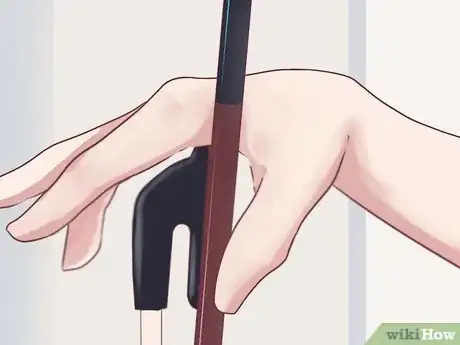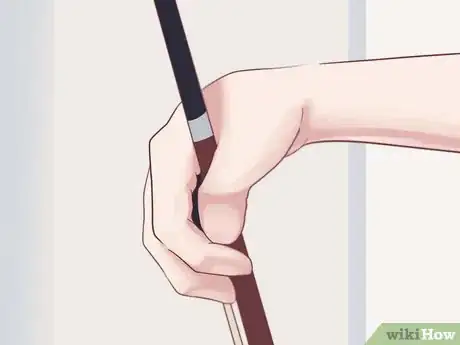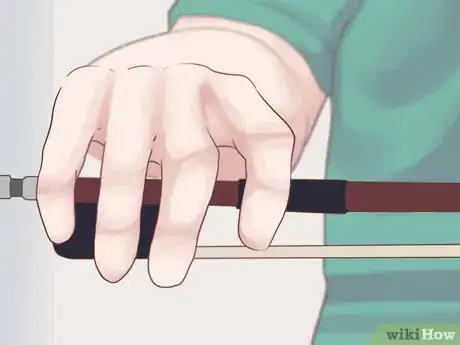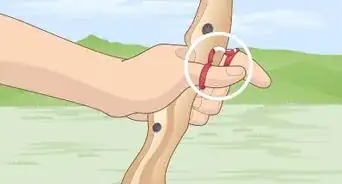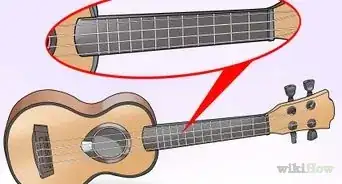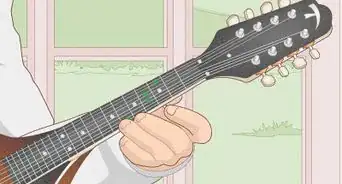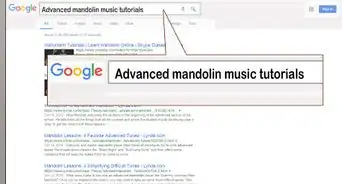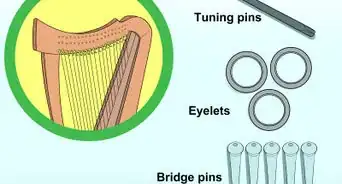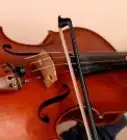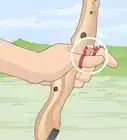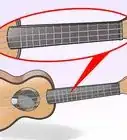This article was co-authored by Dalia Miguel. Dalia Miguel is a violinist and violin instructor based in the San Francisco Bay Area. She is studying Music Education and Violin Performance at San Jose State University and has been playing violin for over 15 years. Dalia teaches students of all ages and performs with a variety of symphonies and orchestras in the Bay Area.
This article has been viewed 32,819 times.
Many stringed instruments such as violins, bass, and cellos require holding both an instrument and a bow. While a lot of instructors spend time describing how to properly hold the instrument, there's less emphasis put on how to hold the bow itself. The fact is, there is not one right way to hold a bow. There is a lot of variation in technique among performers who play the same instrument, and many instructors have their own ideas about how a bow should be held. The proper way to hold a bow also varies depending on what type of stringed instrument you are playing. There are several basic principles to learn to get started with several major stringed instruments.
Steps
Holding a Violin or Viola Bow
-
1Form a ring with your thumb and fingers. Hold the bow in a vertical position using your non-dominant hand. With your dominant hand, form a loose ring with your thumb and both the middle and ring fingers.
- Note that your index and pinky fingers should naturally curve down toward your thumb, as well. Do not touch your thumb with those fingers, but keep them relaxed and perched in that curved position.
-
2Place the bow into your curved hand. With the bow hair facing you, gently open the ring you created so that you can slide the stick of the bow inside.
- The stick should rest on your thumb right at the point where the frog (the device where the bow hair is held and can be adjusted) meets the leather bow grip.
Advertisement -
3Let the remaining fingers fall into place. Bring the index and ring fingers down over the opposite side of the frog. The pads of those fingers should rest directly on the frog.
- Your index finger should rest around the stick at a finger's space away from the middle finger, and the pinky should curve and rest on top of the bow stick.
- You should gently hold the bow without gripping it. Your fingers should be curved in a natural, relaxed form, and your joints should not be stiff. Your palm should also remain soft.
-
4Allow for differences in the down stroke and upstroke.[1] The position described here is the basic position you will use when making both a down stroke and an upstroke. But you should be relaxed and accept gradual changes in this position as you move your bow along the instrument.
- In general, your fingers will be more arched during a down stroke, but during an upstroke your fingers will become more elongated.
-
5Avoid overextending and tensing your joints. While playing, be sure that you keep your hands and joints free from tension. It should be a comfortable and relaxed grip.
- Your first and second finger joints should all be bent slightly, with no hyperextensions. Otherwise you will not have a lot of control and your strokes will be short.
Holding a Cello Bow
-
1Place your thumb on the frog. The thumb of your dominant hand needs to rest on the point of contact between the bow and the frog, which is the device at the end of the bow hairs where they can be tightened. Your thumb will end up being wedged between the bow hairs and the bow stick, somewhere between the frog itself and the leather pad next to it.
- The bow should be in a horizontal position. Hold it straight across with your non-dominant hand placed at the middle or the far end as you position your dominant hand correctly. Release the bow from your non-dominant hand once you set your bow hold.
- Note that the portion of the bow used for playing will face toward your non-dominant side. For right-handed cellists, this will be the left; for left-handed cellists, this will be the right.
-
2Turn your wrist.[2] Relax your hand and turn the wrist slightly to the left, in toward your body.
- If you are left-handed and holding the bow with a dominant left hand, turn the wrist slightly to the right.
-
3Allow your fingers to relax into place. The remaining fingers should curve gently over the top of the bow stick. The pinky finger should not be allowed to rest on top of the bow stick, as it might with a bow stick for a viola or violin. Instead, the pinky should also extend downward with the other three fingers.
- While it is not essential, the middle finger usually lies just opposed to the thumb from the opposite side of the stick. The ring finger is usually on the side of the frog, and the first joint of your pointer finger will usually end up on the leather pad or metal winding ahead of the frog.
- Even though the exact placement of your fingers can vary, you should not allow your thumb to collapse back as you play. It needs to remain gently bent in a normal direction.
- Most of your leverage will come from your thumb, pinky, and ring finger as you play.
-
4Keep your wrist relaxed. Do not press the bow to the strings of the cello. Lightly lay the bow on the strings as you hold it and as you play.[3]
- Ultimately, as you play, you need to have a loose, relaxed grip that is just firm enough to control the direction of the bow.
Holding a German Bass Bow
-
1Hold the bow downward.[4] Keep the bow facing vertically downward with the frog pointed up. Rest your hand on top in an open "handshake" position, with your palm resting lightly on top of the frog.
- The "frog" refers to the enclosed mechanism that holds and tightens the bow hair.
- A "handshake" position simply refers to the sort of position you would hold your hand in if you were preparing to shake hands with someone.
- Note that this method is one of the most common ways to hold a German bow, but it is not the only way. If you want to explore different techniques, talk it over with a bass teacher or with a more experienced bassist.
-
2Turn the bow until it touches your index finger. Gradually turn the bow sideways, drawing the frog further into the palm of your hand and pointing the bow inward toward your body.
- The tip of your bent thumb should just barely touch the tip of your index finger, and both should rest lightly on top of the bow.
- Do not pinch the bow in between your thumb and index finger. They should only rest on top of the bow and should not grab onto it directly.
-
3Let your remaining fingers fall into place. Position your middle finger so that it rests directly next to the index finger. The ring finger should rest next to the middle finger, and the pinky should rest beneath the frog.
- Your pinky should touch the outer part of the ferrule, the silver part of your bow.
- Essentially, the bow will be cupped gently inside of your hand and held in a horizontal position as you play.
-
4Maintain your hold while playing. Keep your hands relaxed and flexible to allow for movement, but not a loss of control, as you play. The wrist should bend slightly as you play downward in order to keep the bow straight across the strings.
- Similarly, the fingers will straighten a bit as you play, but be sure they do not hyperextend, which will reduce your control and make your transitions difficult on the backstroke.
Holding a French Bass Bow
-
1Relax your hand over the bow. Hold the middle of the bow with your non-dominant hand. Rest your dominant hand over the bow, just above the frog. Keep the fingers of your dominant hand relaxed and naturally spread apart.
- The bow should be in a horizontal position.
-
2Allow your fingers to fall into place. Bend the thumb slightly so that the tip touches the point at which the frog meets the rest of the bow, or the "contact point." Your other fingers should gently curve over the top of the bow stick and down the side.
- Do not allow the pinky finger to rest on top of the bow stick. This position might be comfortable to you if you have ever played the violin or viola, but your hand will not have enough support if you repeat it with the French bow. Instead, the pink should curve and extend over the top of the bow stick with the rest of the fingers.
- Release the bow from your non-dominant hand once you have a good grasp with your dominant hand.
- You can let your fingers extend past the bow, or you can keep them perched higher up. The choice is yours. Experiment to determine what placement feels most natural and gives you the most control.
-
3Try another hold if this one is not comfortable. While the method just described is the most common holding technique used for a French bow, there are variations you can use if holding the bow in this way feels awkward or uncomfortable for you.
- Try imitating the placement of teachers, mentors, or favorite performers to try slight variations on the French hold, such as placing the pinky finger in the "U" of the frog. Playing a bass is very personal, but it takes practice to find your ideal holding position.
- The length of your fingers and size of your hands will likely determine how "relaxed" your hold is, or how your spread apart your fingers tend to be on the bow. Try bringing your fingers closer or farther apart along the length of the frog.
- One good rule of thumb, regardless of your hand size, is to place your fingers a natural distance apart. You can locate this natural distance by allowing your hands to fall at your sides, naturally curving at the fingers and thumbs. The distance between your fingers in this natural relaxed posture should be the same when you grip the bow.
-
4Keep your hand in place as you play. The initial grip is much easier than maintaining that grip through heavy playing. It is important to exercise your hands with daily playing so that you will have the stamina to hold your grip through several songs.
- Do not overstrain any particular fingers. Try to keep the tension between all of your fingers and thumb. Do not allow your pinky or thumb to straighten.
Expert Q&A
Did you know you can get expert answers for this article?
Unlock expert answers by supporting wikiHow
-
QuestionWhat is the proper way to hold a bow?
 Dalia MiguelDalia Miguel is a violinist and violin instructor based in the San Francisco Bay Area. She is studying Music Education and Violin Performance at San Jose State University and has been playing violin for over 15 years. Dalia teaches students of all ages and performs with a variety of symphonies and orchestras in the Bay Area.
Dalia MiguelDalia Miguel is a violinist and violin instructor based in the San Francisco Bay Area. She is studying Music Education and Violin Performance at San Jose State University and has been playing violin for over 15 years. Dalia teaches students of all ages and performs with a variety of symphonies and orchestras in the Bay Area.
Experienced Violin Instructor
-
QuestionIf my thumb tends to straighten itself out as I play, how can I get it to stay bent? I play a violin.
 Community AnswerIf you're double jointed, pop the thumb joint forward and lock your thumb into a curve, if you aren't double jointed, just bend your thumb a little off to the side until it fits well.
Community AnswerIf you're double jointed, pop the thumb joint forward and lock your thumb into a curve, if you aren't double jointed, just bend your thumb a little off to the side until it fits well.
Warnings
- As you learn how to hold your bow, remember to never touch the hairs on the bow itself. If you do, your hand will deposit oils and dirt on it, which will make it dirty and keep it from becoming sticky when rosin is applied, ruining the sound of the instrument.⧼thumbs_response⧽
References
About This Article
To hold a violin or viola bow, first make a ring with your dominant hand by holding your thumb against your middle and ring fingers. Then, slide the bow vertically into the ring with the bow hair facing you. Rest the point where the frog meets the leather grip against your thumb. Finally, rest the pads of your index and pinky fingers on the opposite side of the frog. Remember to keep your fingers relaxed and not to grip the bow tightly. To learn how to hold a cello or bass bow, scroll down!

